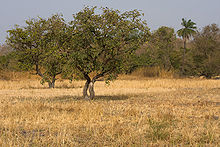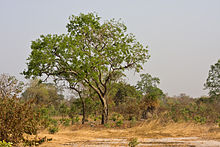Wildlife of the Gambia


The wildlife of the Gambia is dictated by several habitat zones over
According to the government of the Gambia, about 3.7% of the land area of the country has been brought under national parks or reserves, and the present wildlife policy is to extend this coverage to 5%. The seven areas included in the protected list are the Niumi National Park, Kiang West National Park, River Gambia National Park, Bao Bolong Wetland Reserve, Abuko Nature Reserve, Tanbi Wetland Complex and the Tanji Karinti River Bird Reserve. These are managed by the Department of Parks and Wildlife Management. The area covered by these parks is 38,000 ha.[3]
The birdlife in the Gambia is colourful and rich, with 560 species inhabiting coastal saltwater, freshwater wetlands, Guinea and Sudan savanna, woodlands and forests, agricultural lands, towns and villages.
Geography


The flat terrain of the Gambia, drained by the Gambia River is categorised under several habitat types. The habitat types are the coast, mangroves and Banto Faros, wetlands, farmlands, savanna and the Sahel habitats, gallery forests and urban habitats.[4]
The coast extends to 40 kilometres (25 mi) into the sea with extensive sea green grass meadows where aqua fauna dominate; the long stretch of beach here, with occasional hills or cliffs, is topped with plants which are salt tolerant and bind the terrain. Above these are the very old beaches at an elevation where the rich vegetation consists of baobab (
Mangroves and Banto Faros are the
Wetlands consist of
Farmlands, including savanna and woodland, form now a dominant habitat in the Gambia where crops were grown initially on a rotation system of 20 years with a fallow period. This practice has since changed to two or three years rotation. While the agricultural crops grown are
Savanna and the Sahel habitats are of two types. One is the southern Guinea savanna which has rich and dense vegetation of over 50 tree species. The other is the Sudanian savanna which is contiguous to the Guinea savanna on the north bank of the Gambia River. These areas are dry woodlands with soils of laterite formations. The local tree species include silk cotton (Bombax costatum), dry-zone mahogany (Khaya senegalensis) in deeper soil areas and African rosewood (Guibourtia coleosperma). Short grasses and shrubs are seen thinly spread in the Sahelian habitats.[5]
The gallery forests (moisture forests), unlike the rainforest, thrive on groundwater and are integral to savannas. It is a rare habitat found only in Abuko Nature Reserve, Pirang Forest Park and in some stretches of the Gambia River with different set of species with some degree of overlap with rainforests.[5]
Urban habitats consist of numerous villages. The open areas in between have large green stretches with a profusion of tree species, particularly mango (Mangifera indica) trees.[5]
Law of the land

Some parts of the land area of the Gambia, under the protection of the Banjul Declaration of 1977, which is the law on wild life, includes seven protected zones. The law prohibits all types of hunting, except of animals harmful to the environment, such as
Fauna
Mammals
More than 100 species of mammals have been reported.[6]
- Bats
- There are 30–40 species of
- Rodents
- Rodents include the Gambian sun squirrel (
- Aquatic mammals
- Aquatic mammals include two species of dolphin, the Atlantic bottlenose dolphin (Trichechus senegalensis).[6]
- Carnivores
- Leopards and hyenas are still occasionally thought to cross into the more remote areas of East Gambia.[6]
- Herbivores
- .
- Primates
- Bijilo forests have endangered Procolobus badius) are a common sight in the Kiang West National Park, Bijilo Forest Park and Abuko Nature Reserve. Guinea baboon (Papio papio), which is large in size and fierce in appearance, is found in the northern region and also in small numbers in the coastal Makasutu Culture Forest.[6][9]
The aardvark is also still reported, although very rarely seen.
Reptiles and amphibians
- There are 40 snake species, 9 of which are venomous, such as Bosc's monitor, Nile monitors (Varanus niloticus), which are voracious predators; tree geckos; and chameleon.[10][11]
- Three species of crocodiles reported are: slender-snouted crocodile (Osteolaemus tetraspis) and West African crocodile; the first two are on the endangered list.[10]
- Amphibians consist of 33 species, toads, tree frogs, crowned bullfrogs, edible bullfrogs and reed frogs.[10][11]
Birds

More than 500 species of birds live in the Gambia.
Butterfly distribution in the Gambia is dictated by the boundary of two major biomes of Sahelian and Guinean Savanna species; it is distinctly different between the rainy season and dry season.[14]
Flora
The vegetation of the Gambia is mostly savanna in the upland areas, inland swamp in the low-lying areas, and mangrove swamp along the banks of the lower Gambia River.[12] The country is almost devoid of true forest cover, the most forested area being the Bijo Forest. Nonetheless it is biologically rich, with an estimated 11,600 plant species many of which are used for medicinal purposes.[6] Many plants are grown for food. The cassava (Manihot esculenta) was brought to the Gambia by the Portuguese between the 17th and 18th centuries. It grows up to 4 metres high and is a staple of the national diet, with each person consuming an average of 100 kg per annum in 2002 according to the Food and Agriculture Organization.[15] Coastal inland forest comprises part of Bijilo Forest Park, Abuko Nature Reserve, Pirang Forest Park, and the River Gambia National Park.[16]
The gummy Combretum glutinosum, Combretum micranthum, Combretum paniculatum and Combretum racemosum are common shrubs in the savanna areas of the country. Combretum paniculatum may be found on the edges of the forests in the north of the country. These plants usually have red petals and the Combretum racemosum has red 4-part flowers, but with inflorescence rimmed by white bracts.[17]
References
- ^ Penney, pp. 5–7
- ^ a b "Ecotourism and Sustainable Wildlife Management Experiences in The Gambia" (PDF). fao.org. Retrieved 7 April 2011.
- ^ "National Parks & Nature Reserves in Gambia". Gambia Guide. Retrieved 7 March 2011.
- ^ a b Emms, pp. 25–28, 44–48
- ^ a b c d e f g h Emms, pp. 25–28
- ^ a b c d e f g Penney, p. 32
- ^ Emms, p. 33
- ^ Emms, p. 34
- ^ Emms, pp. 31–32
- ^ a b c Penney, p. 37
- ^ a b Emms, pp. 38–40
- ^ a b "Plant and animal life". Encyclopædia Britannica. Retrieved 7 April 2011.
- ^ Emms, p. 44
- ISBN 978-0-9558636-2-2.
- ^ "Cassava in Gambia". Access Gambia. Retrieved 7 April 2011.
- ^ Penney, p. 44
- ISBN 978-0-521-26192-0.
Bibliography
- Emms, Craig; Barnett, Linda & Human, Richard (2006). The Gambia. Bradt Travel Guides. ISBN 978-1-84162-137-1.
- Penney, David (2009). Field Guide to Wildlife of The Gambia: an introduction to common flowers & animals. Siri Scientific Press. ISBN 978-0-9558636-1-5.
Further reading
- Penney, D. 2009. Common Spiders and Other Arachnids of The Gambia, West Africa. Siri Scientific Press, Manchester. ISBN 978-0-9558636-3-9.
